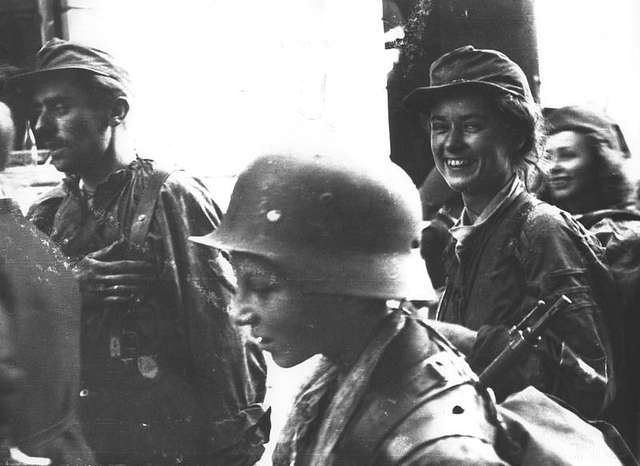OPINIONS
Date: 25 October 2022 Author: Mariusz Patey
More Than Home Army Soldiers: Various Concepts of Independence Struggle After 1939 Defensive War. The Biographies of Irena Iłłakowiczowa and Klementyna Mańkowska pt.1
This article discusses the Military Organization Lizard Union (Organizacja Wojskowa Związek Jaszczurczy, OW ZJ) and the Musketeers (Muszkieterzy)––Poland’s World War II resistance movement that both fought Nazi Germany and the Soviet Union, albeit are little known to the public. This paper also recounts the biographies of two Polish female intelligence officers––Irena Iłłakowiczowa and Klementyna Mańkowska. The author attempted to depict varying ways to fight for freedom while not giving any hasty assessment.

After allied Soviet and Nazi German troops defeated Polish forces in September 1939, the occupation of Poland began its bloody rule of terror. Once a new occupation administration was created, Poles began to form some organizations to fight for freedom. Clandestine resistance movements appeared, created upon prewar political or military institutions. The most notable of them all was the Service for Poland’s Victory (Służba Zwycięstwu Polski, SZP), later renamed the Union of Armed Struggle (Związek Walki Zbrojnej, ZWZ) and the Home Army (Armia Krajowa, AK). Past 1945, other resistance or guerilla institutions came to light, including Freedom and Independence Association (Wolność i Niezawisłość, WiN), Peasants’ Battalions (Bataliony Chłopskie, BCh), National Military Organization (Narodowa Organizacja Wojskowa, NOW) that in 1945 became the National Military Union (Narodowe Zjednoczenie Wojskowe).
Civilian institutions of the Polish Underground State were formed alongside other organizations that yet recognized the London-based Polish government-in-exile. There were also some Soviet-linked Communists whose top mission was to cripple the Polish government-in-exile while pursuing Moscow’s interests in Poland. Most of Poland’s independence and patriotic movements acted unanimously until June 22, 1941, claiming their country had to fight both against Nazi Germany and Soviet Russia. The London-based government-in-exile made efforts to consolidate all Polish resistance movements into the Union of Armed Struggle–Home Army. Most unions were scrambled amid a climate of distrust, the ambitions of their leaders, and concerns of being compromised as the risk grew with just single one resistance movement instead of them being shattered.
Upon the Nazi invasion of the Soviet Union, the Polish government-in-exile took action to normalize ties with Moscow––a de facto oppressor. On July 30, 1941, Poland and the Soviet Union signed the Sikorski-Mayski Agreement, a treaty that yet sparked controversy among Polish national movements. Many believed Stalin, who was back then in a tough military position, sought to throw Poles into the war as cannon fodder and then seize Poland again––as soon as the Red Army would conquer Nazi Germany. Some reckoned Stalin aspired to gain a reputation, somewhat tarnished by Soviet collaboration with Nazi Germany, its occupation of the Baltic States, and the Soviet-Finnish War (1939–1940), to receive U.S. military assistance. Gen. Sikorski notched up a conspicuous success as Stalin carried out a one-time amnesty that affected both the military and the civilians held in Soviet prisons and gulags. Those who felt concerned about Stalin’s hostile intentions were right. Soviet intelligence agents tried to creep into Poles reaching the army corps created by Gen. Władysław Anders.
In 1942 the Red Army was in a better situation on the front line––unlike the Polish Armed Forces deployed in the Soviet Union. As Poles suffered severe food shortages while Soviet officials urged the government-in-exile to send troops without prior military training or proper equipment, the Polish Armed Forces eventually quit the Soviet Union. Between August 10, 1942 and early September, most Polish soldiers and civilians were evacuated.
Then on April 13, 1943, the Germans announced that they had discovered mass graves of Polish officers in the Katyn forest near Smolensk. Red Cross investigators came to the scene to exhume corpses. On April 25, 1943 Stalin severed diplomatic relations with the London-based Polish government-in-exile when the latter had asked for an investigation by the International Committee of the Red Cross.
Sikorski, who headed the Polish government-in-exile during World War II, died in an air crash on July 4, 1943. His death and Soviet military successes on the front line enfeebled Poland’s international standing. Stalin openly submitted claims to the whole Polish territory to be controlled by the Union of Polish Patriots, a Communist organization having ties to the Soviet Union.
UK, U.S., and Soviet officials met in Tehran to attend the conference that took place on November 28–December 1, 1943. The three established a new security architecture in Europe. Seeking to appease conscience of Western officials, Stalin gave his consent to set up a democratic Poland. Yet he projected his own understanding of “democracy”. Any referenda or elections took place under the watchful eye of “democratic” forces, or in fact undercover Soviet intelligence officers or law enforcement institutions for an “independent Polish state”. Stalin set out one condition––a new Soviet-friendly “democratic” government was to be installed while Soviet territorial claims made after September 17, 1939 recognized. Those to guarantee Polish-Soviet friendship were “members of the progressive and democratic faction” in the prospective Polish cabinet. It was a bizarre situation as the Soviet Union––officially tied to the Allies––refused to recognize the government of an allied state. The United States and the United Kingdom prompted Poland that their alliance with Moscow was a top priority.
As a conflict of interests ensued between Poland and the Soviet Union, many Poles wondered whether to back Moscow in its fight against Nazi Germany or embark on a more adapted strategy. Efforts were made to protect Poles under the Nazi occupation in hope of the Nazi German defeat. Many also hoped the Soviet Union would lack power to drive any wedges into the Polish state, at that time to be reborn. Later in 1944, when it became clear the Red Army would capture vast swathes of Polish territory, preparations were in hand to stage an anti-Soviet resistance movement. Many anticipated a conflict between the Allies and Stalin whose result would be a free Poland.
The Polish government-in-exile and the Home Army Command preferred not to provoke the Soviet ire, believing the Allies would never leave war-torn Poland alone. Despite intelligence reports that might have upset many, they carefully made no contact with Soviet outlets in occupied Poland. Many turned a deaf ear to what was rumored about the true intentions of the Soviets. The Kremlin would spread fake rumors that the Home Army had been unprepared to defy Nazi Germany or that its troops even had been in cahoots with Berlin, which targeted any interests of the anti-Hitler coalition. The Soviet Union also challenged the government’s legitimacy, claiming both the government and the Polish Underground State enjoyed low approval ratings among Poles. In response, the Home Army Command ordered Operation Tempest, or a series of anti-Nazi uprisings that spanned all pre-war Polish provinces in the country’s east.
The Soviet Union eagerly accepted help from the Home Army––and what followed was that the NKVD either disarmed and arrested Polish troops or incorporated them into Soviet-operating military, known as the Berling Army. Stalin cared little about how much effort the Polish resistance movement made or how many Polish civilians perished during wartime. He saw countries across Central and Eastern Europe merely as his war booty. As the front line came near, Soviet forces staged attacks against Home Army troops and other Polish resistance groups in eastern Poland.
As Soviet forces advanced, in the Novogrudok region, some Polish resistance fighters, including Adolf Pilch (known by his nom-de-guerre “Góra” and “Dolina”), made a tactical deal with Nazi German forces to save soldiers from death at the hands of Communists. The Warsaw Uprising, which was to save the independence of Poland, sensibilize the public, and eventually refute Stalin’s arguments, practically ended up with the demise of the Polish Underground State.
For Poland, a much-desired scenario was to make Nazi Germany maintain the eastern front while simultaneously being demolished in the west, a situation that occurred during World War I. Another course of events––albeit more probable––was the second Soviet occupation and a clash between the Soviet Union and the Allies, whose outcome would be Poland’s regaining independence. But first, Poles had to brace for Soviet occupation. In both, a priority was to make the nation endure wartime hardships while consolidating military and political structures.
Those that fought both against the Soviet Union and Nazi Germany were OW ZJ and the Musketeers (Muszkieterzy), a clandestine intelligence group.
Since late 1943, resistance fighters shifted focus to defying Soviet intelligence agents and Communist organizations. Past 1945, the Soviet Union indeed took control of Poland through a Kremlin-loyal puppet government under the guise of “democratic” forces in the “reborn” Polish state. Some Polish patriots wondered whether their interests overlapped those of the country’s Western allies. Despite what London and Washington aspired to at that time, they played a political game aimed at the “ally of the allies” and its intentions. Poland’s anti-Communist groups had indeed high hopes of a Soviet-Western war, but in vain. The Cold War began in 1947 and Poles had to march a long path towards independence.
Support Us
If content prepared by Warsaw Institute team is useful for you, please support our actions. Donations from private persons are necessary for the continuation of our mission.
All texts published by the Warsaw Institute Foundation may be disseminated on the condition that their origin is credited. Images may not be used without permission.















